Analysis Business Process of GAAM
VerifiedAdded on 2022/11/19
|12
|3104
|271
AI Summary
This report aims to conduct a thorough analysis of the process necessary for business followed by the purchase department in GAAM Australia. It conducts a thorough research of the participants, inputs and outputs of the existing process implemented by the entity. After referring to various sources of literature available, it tries to identify the faults in the procedures being implemented by the organisation.
Contribute Materials
Your contribution can guide someone’s learning journey. Share your
documents today.
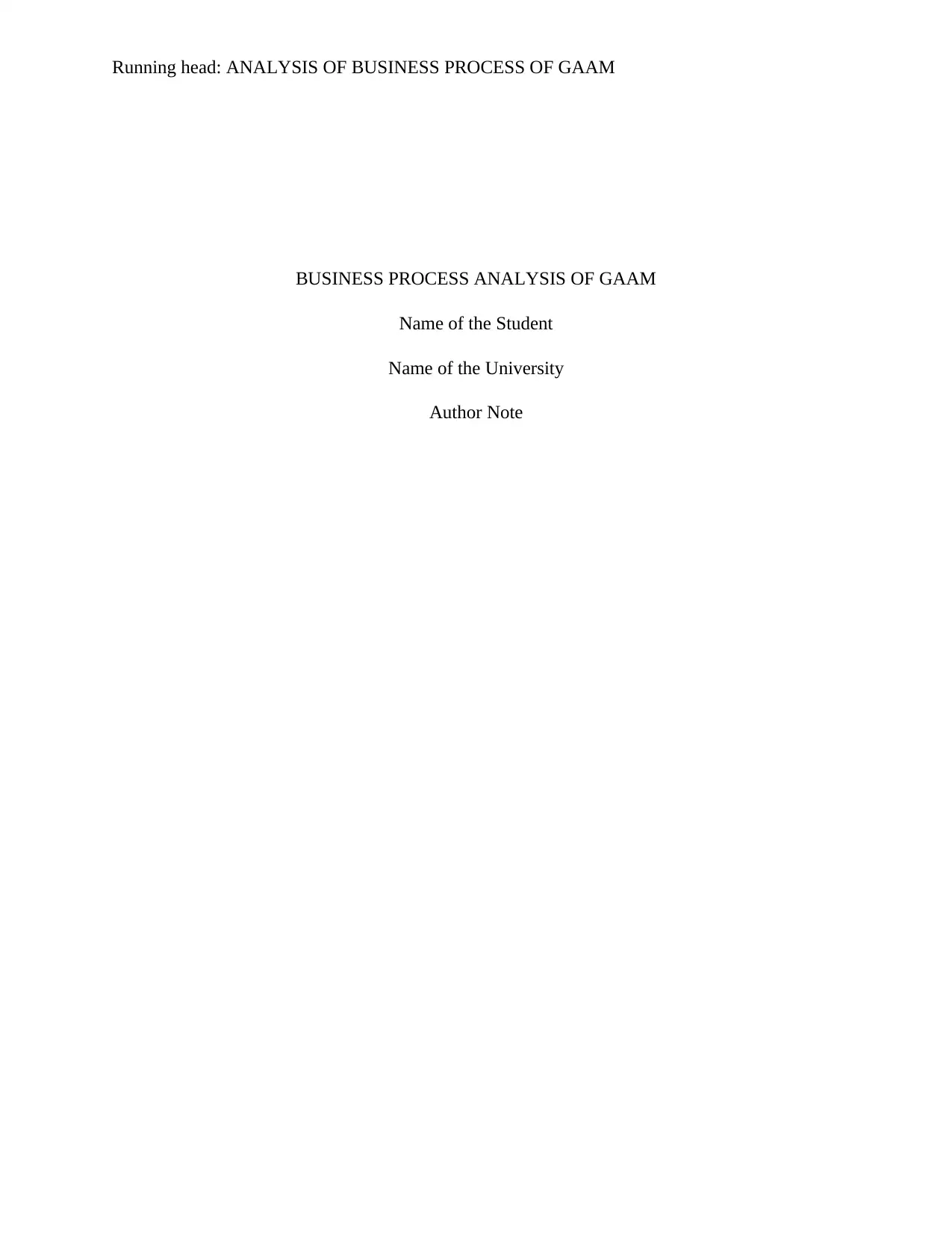
Running head: ANALYSIS OF BUSINESS PROCESS OF GAAM
BUSINESS PROCESS ANALYSIS OF GAAM
Name of the Student
Name of the University
Author Note
BUSINESS PROCESS ANALYSIS OF GAAM
Name of the Student
Name of the University
Author Note
Secure Best Marks with AI Grader
Need help grading? Try our AI Grader for instant feedback on your assignments.
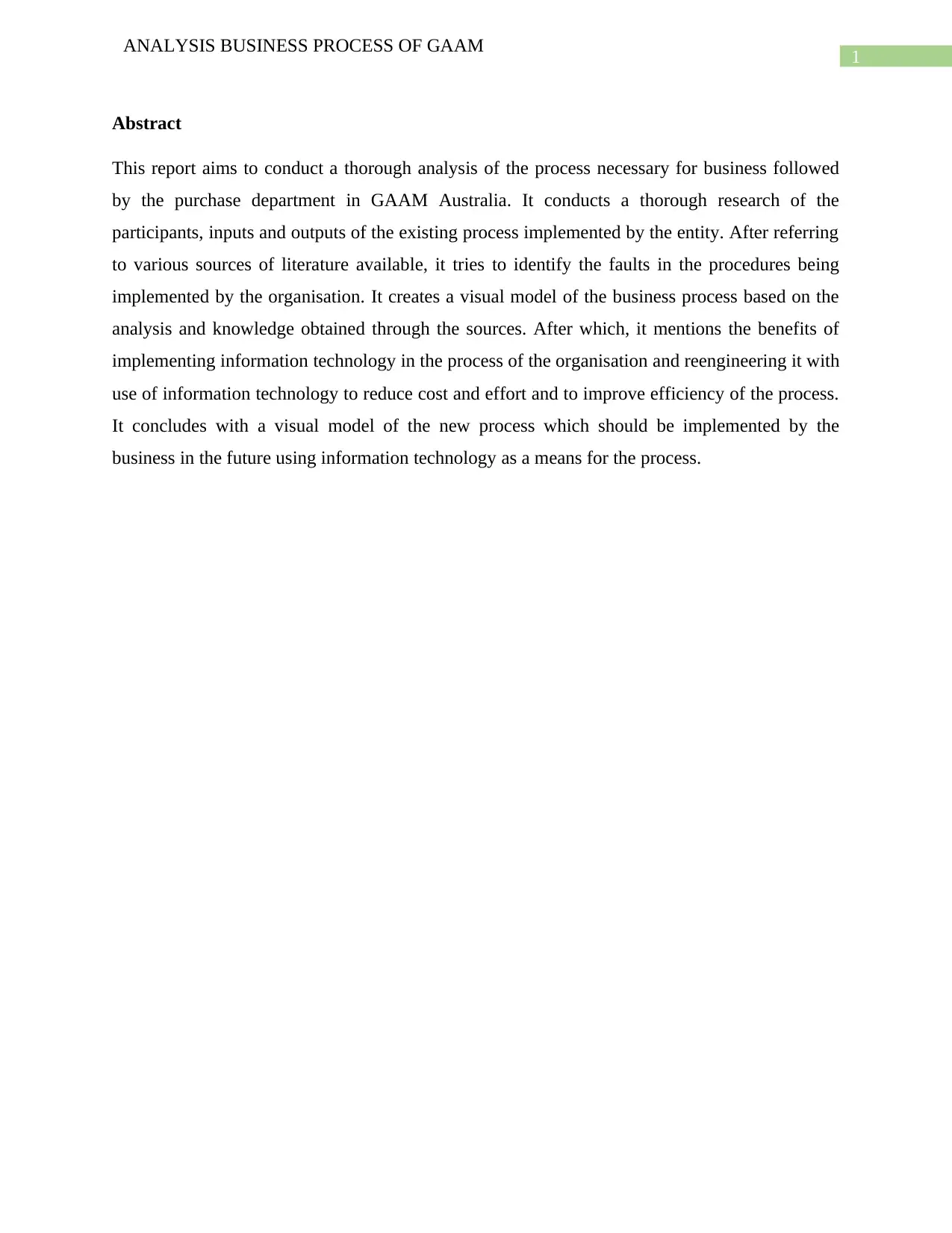
1
ANALYSIS BUSINESS PROCESS OF GAAM
Abstract
This report aims to conduct a thorough analysis of the process necessary for business followed
by the purchase department in GAAM Australia. It conducts a thorough research of the
participants, inputs and outputs of the existing process implemented by the entity. After referring
to various sources of literature available, it tries to identify the faults in the procedures being
implemented by the organisation. It creates a visual model of the business process based on the
analysis and knowledge obtained through the sources. After which, it mentions the benefits of
implementing information technology in the process of the organisation and reengineering it with
use of information technology to reduce cost and effort and to improve efficiency of the process.
It concludes with a visual model of the new process which should be implemented by the
business in the future using information technology as a means for the process.
ANALYSIS BUSINESS PROCESS OF GAAM
Abstract
This report aims to conduct a thorough analysis of the process necessary for business followed
by the purchase department in GAAM Australia. It conducts a thorough research of the
participants, inputs and outputs of the existing process implemented by the entity. After referring
to various sources of literature available, it tries to identify the faults in the procedures being
implemented by the organisation. It creates a visual model of the business process based on the
analysis and knowledge obtained through the sources. After which, it mentions the benefits of
implementing information technology in the process of the organisation and reengineering it with
use of information technology to reduce cost and effort and to improve efficiency of the process.
It concludes with a visual model of the new process which should be implemented by the
business in the future using information technology as a means for the process.
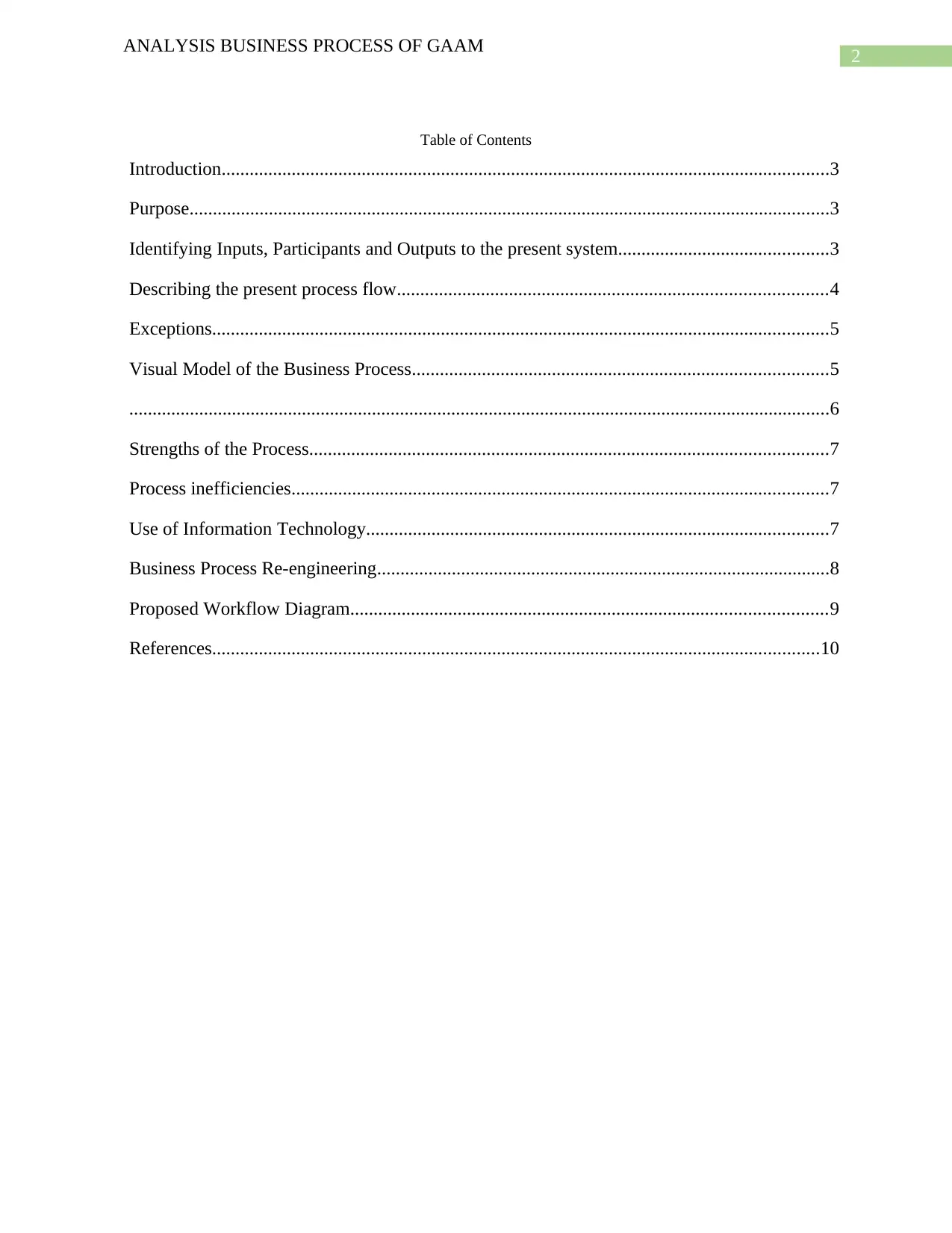
2
ANALYSIS BUSINESS PROCESS OF GAAM
Table of Contents
Introduction..................................................................................................................................3
Purpose.........................................................................................................................................3
Identifying Inputs, Participants and Outputs to the present system.............................................3
Describing the present process flow............................................................................................4
Exceptions....................................................................................................................................5
Visual Model of the Business Process.........................................................................................5
......................................................................................................................................................6
Strengths of the Process...............................................................................................................7
Process inefficiencies...................................................................................................................7
Use of Information Technology...................................................................................................7
Business Process Re-engineering.................................................................................................8
Proposed Workflow Diagram......................................................................................................9
References..................................................................................................................................10
ANALYSIS BUSINESS PROCESS OF GAAM
Table of Contents
Introduction..................................................................................................................................3
Purpose.........................................................................................................................................3
Identifying Inputs, Participants and Outputs to the present system.............................................3
Describing the present process flow............................................................................................4
Exceptions....................................................................................................................................5
Visual Model of the Business Process.........................................................................................5
......................................................................................................................................................6
Strengths of the Process...............................................................................................................7
Process inefficiencies...................................................................................................................7
Use of Information Technology...................................................................................................7
Business Process Re-engineering.................................................................................................8
Proposed Workflow Diagram......................................................................................................9
References..................................................................................................................................10
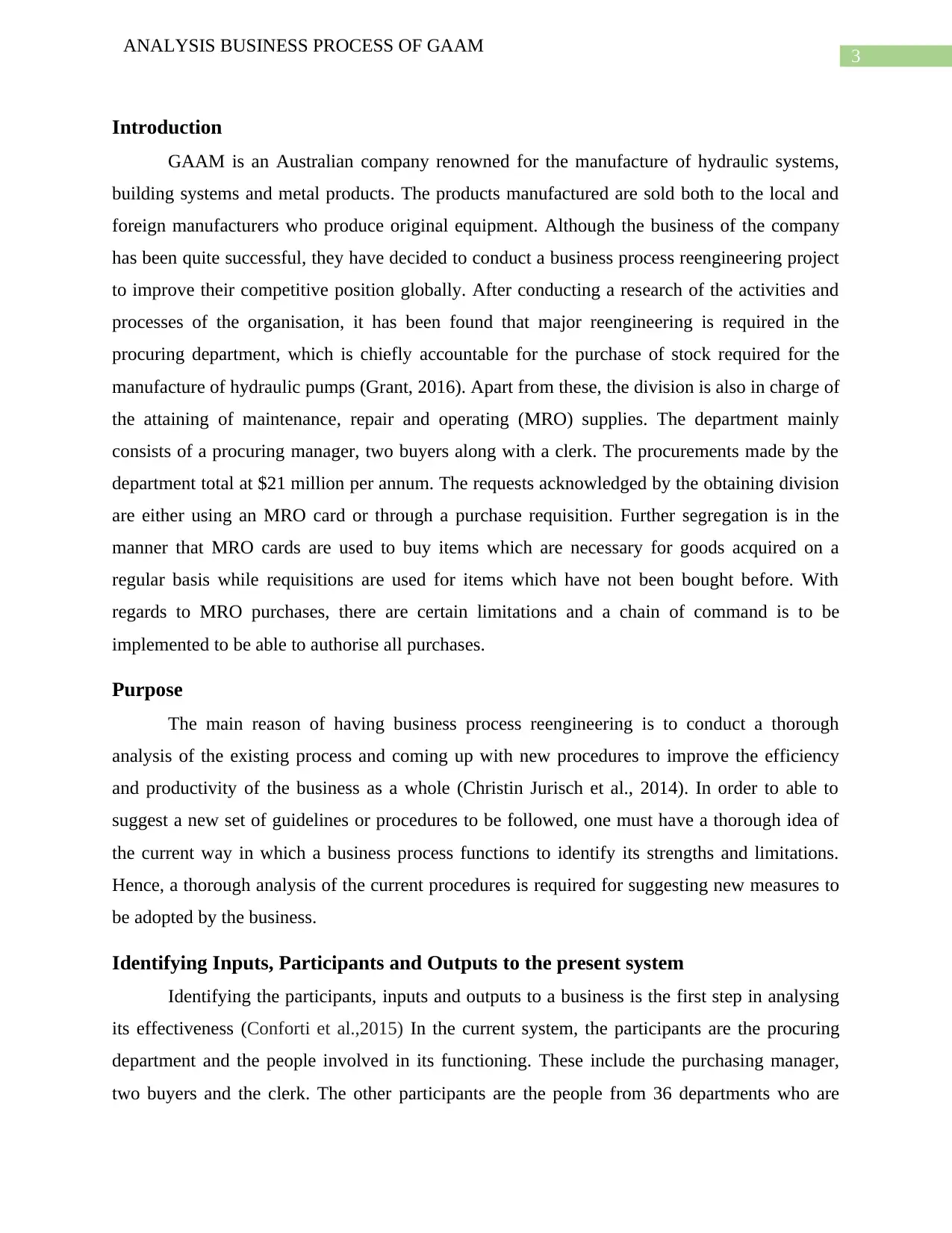
3
ANALYSIS BUSINESS PROCESS OF GAAM
Introduction
GAAM is an Australian company renowned for the manufacture of hydraulic systems,
building systems and metal products. The products manufactured are sold both to the local and
foreign manufacturers who produce original equipment. Although the business of the company
has been quite successful, they have decided to conduct a business process reengineering project
to improve their competitive position globally. After conducting a research of the activities and
processes of the organisation, it has been found that major reengineering is required in the
procuring department, which is chiefly accountable for the purchase of stock required for the
manufacture of hydraulic pumps (Grant, 2016). Apart from these, the division is also in charge of
the attaining of maintenance, repair and operating (MRO) supplies. The department mainly
consists of a procuring manager, two buyers along with a clerk. The procurements made by the
department total at $21 million per annum. The requests acknowledged by the obtaining division
are either using an MRO card or through a purchase requisition. Further segregation is in the
manner that MRO cards are used to buy items which are necessary for goods acquired on a
regular basis while requisitions are used for items which have not been bought before. With
regards to MRO purchases, there are certain limitations and a chain of command is to be
implemented to be able to authorise all purchases.
Purpose
The main reason of having business process reengineering is to conduct a thorough
analysis of the existing process and coming up with new procedures to improve the efficiency
and productivity of the business as a whole (Christin Jurisch et al., 2014). In order to able to
suggest a new set of guidelines or procedures to be followed, one must have a thorough idea of
the current way in which a business process functions to identify its strengths and limitations.
Hence, a thorough analysis of the current procedures is required for suggesting new measures to
be adopted by the business.
Identifying Inputs, Participants and Outputs to the present system
Identifying the participants, inputs and outputs to a business is the first step in analysing
its effectiveness (Conforti et al.,2015) In the current system, the participants are the procuring
department and the people involved in its functioning. These include the purchasing manager,
two buyers and the clerk. The other participants are the people from 36 departments who are
ANALYSIS BUSINESS PROCESS OF GAAM
Introduction
GAAM is an Australian company renowned for the manufacture of hydraulic systems,
building systems and metal products. The products manufactured are sold both to the local and
foreign manufacturers who produce original equipment. Although the business of the company
has been quite successful, they have decided to conduct a business process reengineering project
to improve their competitive position globally. After conducting a research of the activities and
processes of the organisation, it has been found that major reengineering is required in the
procuring department, which is chiefly accountable for the purchase of stock required for the
manufacture of hydraulic pumps (Grant, 2016). Apart from these, the division is also in charge of
the attaining of maintenance, repair and operating (MRO) supplies. The department mainly
consists of a procuring manager, two buyers along with a clerk. The procurements made by the
department total at $21 million per annum. The requests acknowledged by the obtaining division
are either using an MRO card or through a purchase requisition. Further segregation is in the
manner that MRO cards are used to buy items which are necessary for goods acquired on a
regular basis while requisitions are used for items which have not been bought before. With
regards to MRO purchases, there are certain limitations and a chain of command is to be
implemented to be able to authorise all purchases.
Purpose
The main reason of having business process reengineering is to conduct a thorough
analysis of the existing process and coming up with new procedures to improve the efficiency
and productivity of the business as a whole (Christin Jurisch et al., 2014). In order to able to
suggest a new set of guidelines or procedures to be followed, one must have a thorough idea of
the current way in which a business process functions to identify its strengths and limitations.
Hence, a thorough analysis of the current procedures is required for suggesting new measures to
be adopted by the business.
Identifying Inputs, Participants and Outputs to the present system
Identifying the participants, inputs and outputs to a business is the first step in analysing
its effectiveness (Conforti et al.,2015) In the current system, the participants are the procuring
department and the people involved in its functioning. These include the purchasing manager,
two buyers and the clerk. The other participants are the people from 36 departments who are
Secure Best Marks with AI Grader
Need help grading? Try our AI Grader for instant feedback on your assignments.
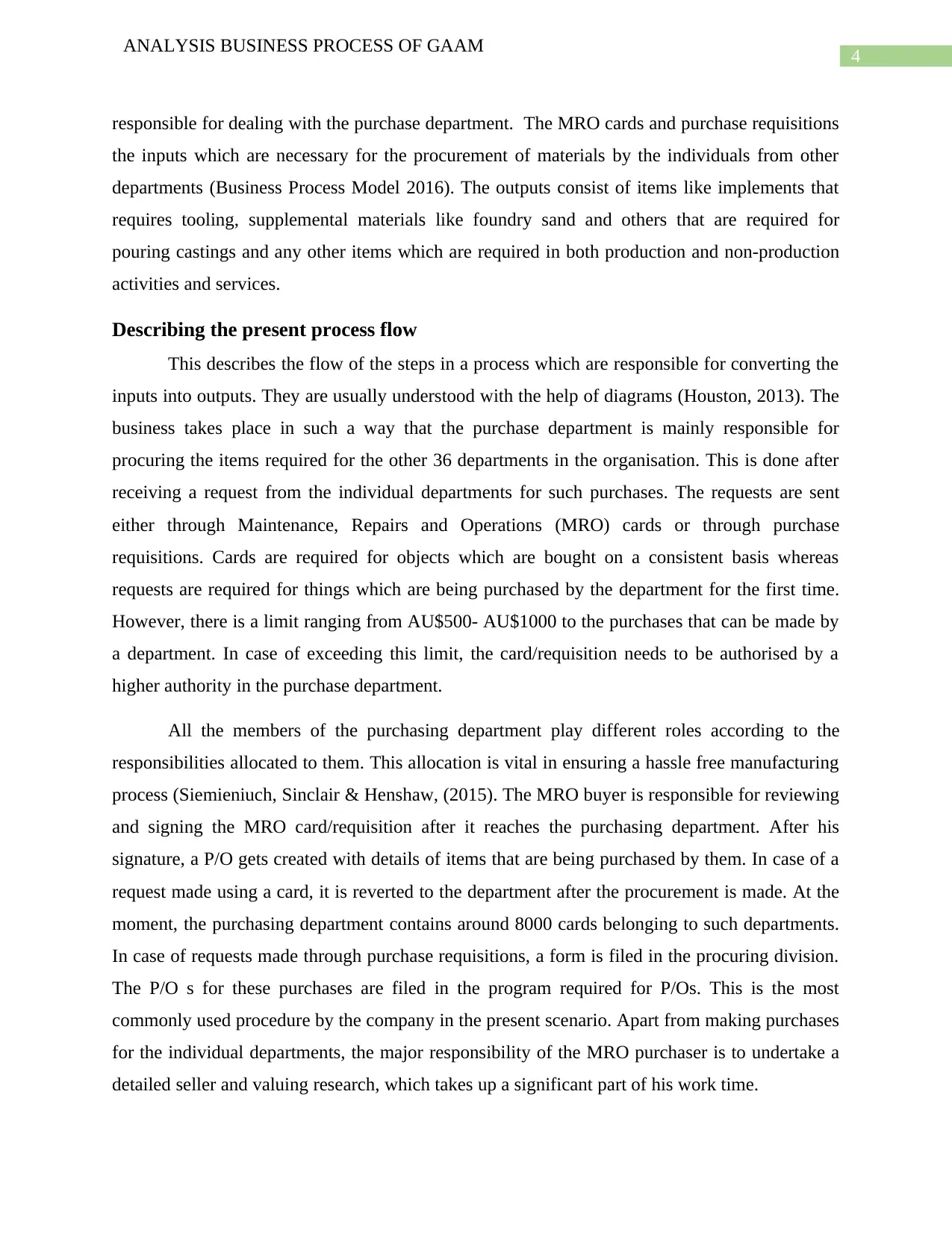
4
ANALYSIS BUSINESS PROCESS OF GAAM
responsible for dealing with the purchase department. The MRO cards and purchase requisitions
the inputs which are necessary for the procurement of materials by the individuals from other
departments (Business Process Model 2016). The outputs consist of items like implements that
requires tooling, supplemental materials like foundry sand and others that are required for
pouring castings and any other items which are required in both production and non-production
activities and services.
Describing the present process flow
This describes the flow of the steps in a process which are responsible for converting the
inputs into outputs. They are usually understood with the help of diagrams (Houston, 2013). The
business takes place in such a way that the purchase department is mainly responsible for
procuring the items required for the other 36 departments in the organisation. This is done after
receiving a request from the individual departments for such purchases. The requests are sent
either through Maintenance, Repairs and Operations (MRO) cards or through purchase
requisitions. Cards are required for objects which are bought on a consistent basis whereas
requests are required for things which are being purchased by the department for the first time.
However, there is a limit ranging from AU$500- AU$1000 to the purchases that can be made by
a department. In case of exceeding this limit, the card/requisition needs to be authorised by a
higher authority in the purchase department.
All the members of the purchasing department play different roles according to the
responsibilities allocated to them. This allocation is vital in ensuring a hassle free manufacturing
process (Siemieniuch, Sinclair & Henshaw, (2015). The MRO buyer is responsible for reviewing
and signing the MRO card/requisition after it reaches the purchasing department. After his
signature, a P/O gets created with details of items that are being purchased by them. In case of a
request made using a card, it is reverted to the department after the procurement is made. At the
moment, the purchasing department contains around 8000 cards belonging to such departments.
In case of requests made through purchase requisitions, a form is filed in the procuring division.
The P/O s for these purchases are filed in the program required for P/Os. This is the most
commonly used procedure by the company in the present scenario. Apart from making purchases
for the individual departments, the major responsibility of the MRO purchaser is to undertake a
detailed seller and valuing research, which takes up a significant part of his work time.
ANALYSIS BUSINESS PROCESS OF GAAM
responsible for dealing with the purchase department. The MRO cards and purchase requisitions
the inputs which are necessary for the procurement of materials by the individuals from other
departments (Business Process Model 2016). The outputs consist of items like implements that
requires tooling, supplemental materials like foundry sand and others that are required for
pouring castings and any other items which are required in both production and non-production
activities and services.
Describing the present process flow
This describes the flow of the steps in a process which are responsible for converting the
inputs into outputs. They are usually understood with the help of diagrams (Houston, 2013). The
business takes place in such a way that the purchase department is mainly responsible for
procuring the items required for the other 36 departments in the organisation. This is done after
receiving a request from the individual departments for such purchases. The requests are sent
either through Maintenance, Repairs and Operations (MRO) cards or through purchase
requisitions. Cards are required for objects which are bought on a consistent basis whereas
requests are required for things which are being purchased by the department for the first time.
However, there is a limit ranging from AU$500- AU$1000 to the purchases that can be made by
a department. In case of exceeding this limit, the card/requisition needs to be authorised by a
higher authority in the purchase department.
All the members of the purchasing department play different roles according to the
responsibilities allocated to them. This allocation is vital in ensuring a hassle free manufacturing
process (Siemieniuch, Sinclair & Henshaw, (2015). The MRO buyer is responsible for reviewing
and signing the MRO card/requisition after it reaches the purchasing department. After his
signature, a P/O gets created with details of items that are being purchased by them. In case of a
request made using a card, it is reverted to the department after the procurement is made. At the
moment, the purchasing department contains around 8000 cards belonging to such departments.
In case of requests made through purchase requisitions, a form is filed in the procuring division.
The P/O s for these purchases are filed in the program required for P/Os. This is the most
commonly used procedure by the company in the present scenario. Apart from making purchases
for the individual departments, the major responsibility of the MRO purchaser is to undertake a
detailed seller and valuing research, which takes up a significant part of his work time.
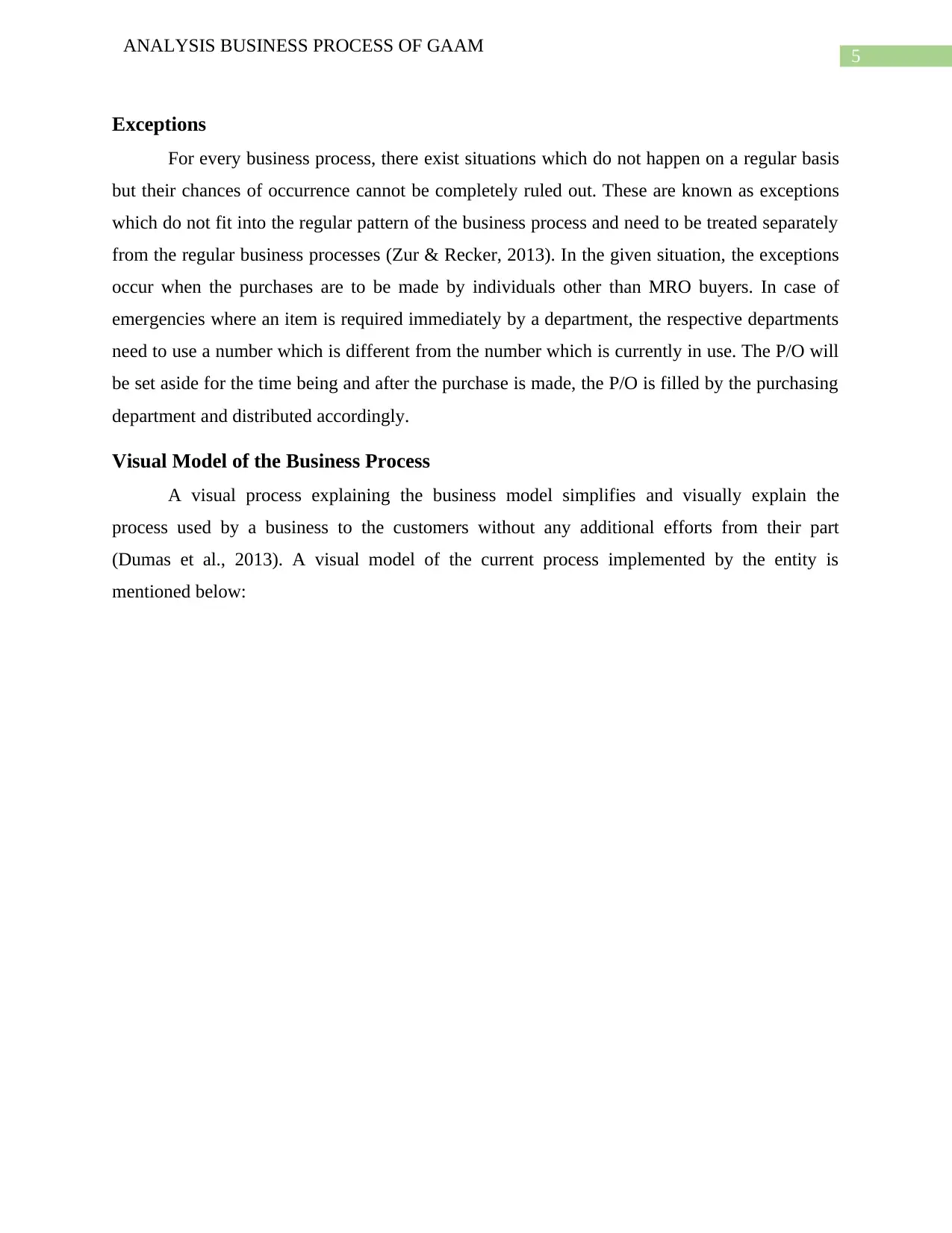
5
ANALYSIS BUSINESS PROCESS OF GAAM
Exceptions
For every business process, there exist situations which do not happen on a regular basis
but their chances of occurrence cannot be completely ruled out. These are known as exceptions
which do not fit into the regular pattern of the business process and need to be treated separately
from the regular business processes (Zur & Recker, 2013). In the given situation, the exceptions
occur when the purchases are to be made by individuals other than MRO buyers. In case of
emergencies where an item is required immediately by a department, the respective departments
need to use a number which is different from the number which is currently in use. The P/O will
be set aside for the time being and after the purchase is made, the P/O is filled by the purchasing
department and distributed accordingly.
Visual Model of the Business Process
A visual process explaining the business model simplifies and visually explain the
process used by a business to the customers without any additional efforts from their part
(Dumas et al., 2013). A visual model of the current process implemented by the entity is
mentioned below:
ANALYSIS BUSINESS PROCESS OF GAAM
Exceptions
For every business process, there exist situations which do not happen on a regular basis
but their chances of occurrence cannot be completely ruled out. These are known as exceptions
which do not fit into the regular pattern of the business process and need to be treated separately
from the regular business processes (Zur & Recker, 2013). In the given situation, the exceptions
occur when the purchases are to be made by individuals other than MRO buyers. In case of
emergencies where an item is required immediately by a department, the respective departments
need to use a number which is different from the number which is currently in use. The P/O will
be set aside for the time being and after the purchase is made, the P/O is filled by the purchasing
department and distributed accordingly.
Visual Model of the Business Process
A visual process explaining the business model simplifies and visually explain the
process used by a business to the customers without any additional efforts from their part
(Dumas et al., 2013). A visual model of the current process implemented by the entity is
mentioned below:
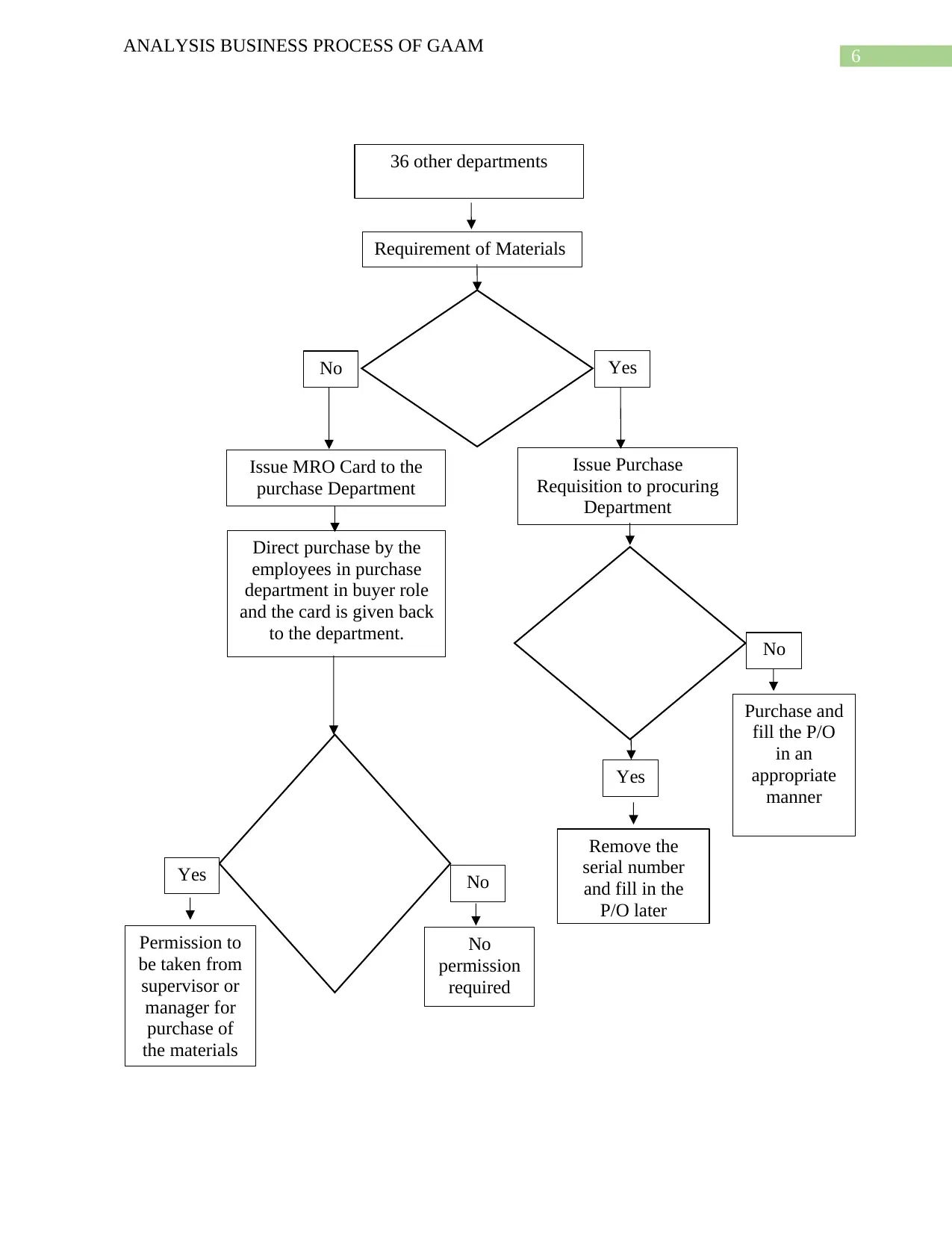
6
ANALYSIS BUSINESS PROCESS OF GAAM
36 other departments
Requirement of Materials
Is the item
new or
existing?
Yes
Issue Purchase
Requisition to procuring
Department
No
Issue MRO Card to the
purchase Department
Direct purchase by the
employees in purchase
department in buyer role
and the card is given back
to the department.
Is the
purchase an
emergency
purchase?
No
Purchase and
fill the P/O
in an
appropriate
manner
Yes
Remove the
serial number
and fill in the
P/O later
Requirement
of materials
more than
allowed limit
of $500-
$1000
NoYes
No
permission
required
Permission to
be taken from
supervisor or
manager for
purchase of
the materials
ANALYSIS BUSINESS PROCESS OF GAAM
36 other departments
Requirement of Materials
Is the item
new or
existing?
Yes
Issue Purchase
Requisition to procuring
Department
No
Issue MRO Card to the
purchase Department
Direct purchase by the
employees in purchase
department in buyer role
and the card is given back
to the department.
Is the
purchase an
emergency
purchase?
No
Purchase and
fill the P/O
in an
appropriate
manner
Yes
Remove the
serial number
and fill in the
P/O later
Requirement
of materials
more than
allowed limit
of $500-
$1000
NoYes
No
permission
required
Permission to
be taken from
supervisor or
manager for
purchase of
the materials
Paraphrase This Document
Need a fresh take? Get an instant paraphrase of this document with our AI Paraphraser
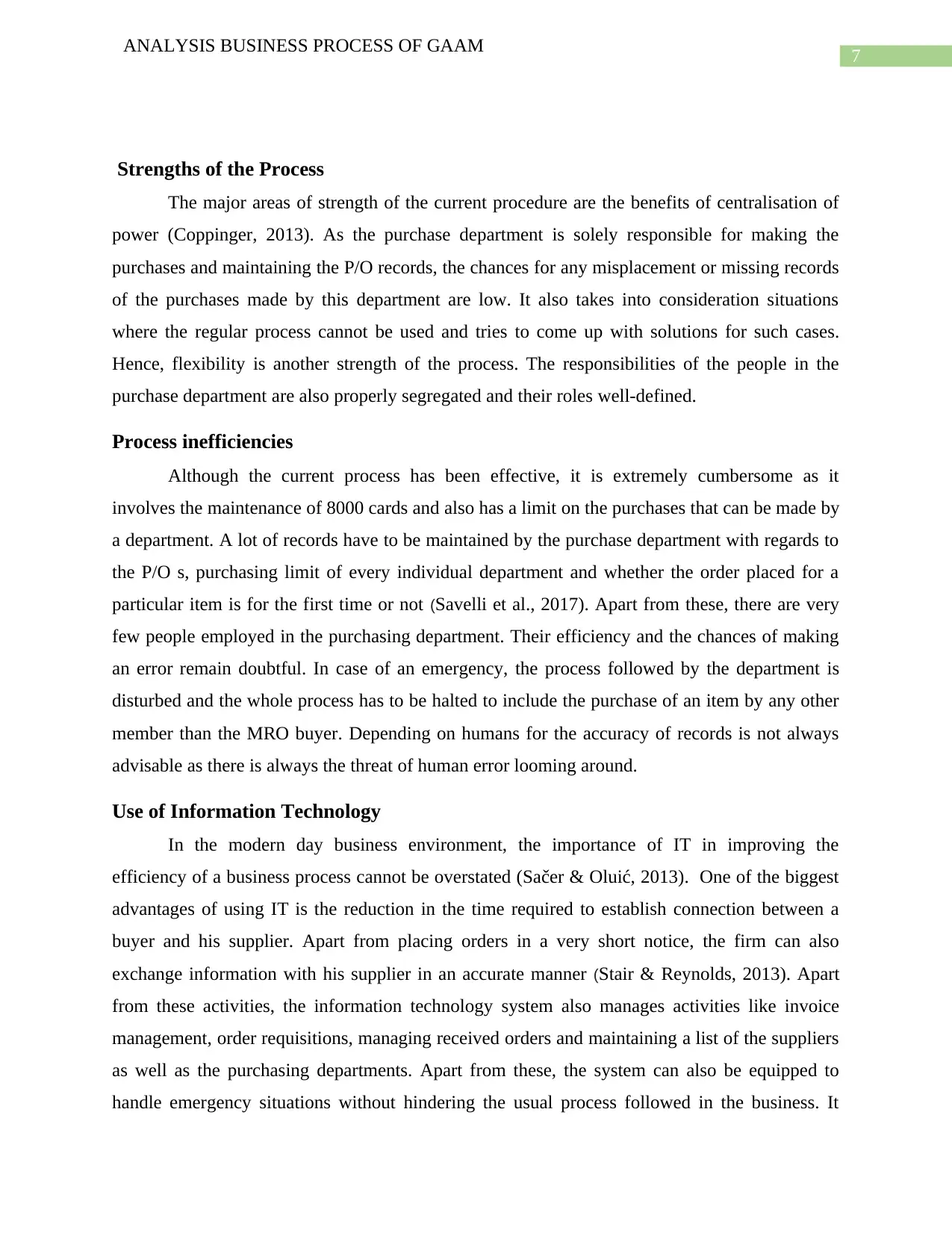
7
ANALYSIS BUSINESS PROCESS OF GAAM
Strengths of the Process
The major areas of strength of the current procedure are the benefits of centralisation of
power (Coppinger, 2013). As the purchase department is solely responsible for making the
purchases and maintaining the P/O records, the chances for any misplacement or missing records
of the purchases made by this department are low. It also takes into consideration situations
where the regular process cannot be used and tries to come up with solutions for such cases.
Hence, flexibility is another strength of the process. The responsibilities of the people in the
purchase department are also properly segregated and their roles well-defined.
Process inefficiencies
Although the current process has been effective, it is extremely cumbersome as it
involves the maintenance of 8000 cards and also has a limit on the purchases that can be made by
a department. A lot of records have to be maintained by the purchase department with regards to
the P/O s, purchasing limit of every individual department and whether the order placed for a
particular item is for the first time or not (Savelli et al., 2017). Apart from these, there are very
few people employed in the purchasing department. Their efficiency and the chances of making
an error remain doubtful. In case of an emergency, the process followed by the department is
disturbed and the whole process has to be halted to include the purchase of an item by any other
member than the MRO buyer. Depending on humans for the accuracy of records is not always
advisable as there is always the threat of human error looming around.
Use of Information Technology
In the modern day business environment, the importance of IT in improving the
efficiency of a business process cannot be overstated (Sačer & Oluić, 2013). One of the biggest
advantages of using IT is the reduction in the time required to establish connection between a
buyer and his supplier. Apart from placing orders in a very short notice, the firm can also
exchange information with his supplier in an accurate manner (Stair & Reynolds, 2013). Apart
from these activities, the information technology system also manages activities like invoice
management, order requisitions, managing received orders and maintaining a list of the suppliers
as well as the purchasing departments. Apart from these, the system can also be equipped to
handle emergency situations without hindering the usual process followed in the business. It
ANALYSIS BUSINESS PROCESS OF GAAM
Strengths of the Process
The major areas of strength of the current procedure are the benefits of centralisation of
power (Coppinger, 2013). As the purchase department is solely responsible for making the
purchases and maintaining the P/O records, the chances for any misplacement or missing records
of the purchases made by this department are low. It also takes into consideration situations
where the regular process cannot be used and tries to come up with solutions for such cases.
Hence, flexibility is another strength of the process. The responsibilities of the people in the
purchase department are also properly segregated and their roles well-defined.
Process inefficiencies
Although the current process has been effective, it is extremely cumbersome as it
involves the maintenance of 8000 cards and also has a limit on the purchases that can be made by
a department. A lot of records have to be maintained by the purchase department with regards to
the P/O s, purchasing limit of every individual department and whether the order placed for a
particular item is for the first time or not (Savelli et al., 2017). Apart from these, there are very
few people employed in the purchasing department. Their efficiency and the chances of making
an error remain doubtful. In case of an emergency, the process followed by the department is
disturbed and the whole process has to be halted to include the purchase of an item by any other
member than the MRO buyer. Depending on humans for the accuracy of records is not always
advisable as there is always the threat of human error looming around.
Use of Information Technology
In the modern day business environment, the importance of IT in improving the
efficiency of a business process cannot be overstated (Sačer & Oluić, 2013). One of the biggest
advantages of using IT is the reduction in the time required to establish connection between a
buyer and his supplier. Apart from placing orders in a very short notice, the firm can also
exchange information with his supplier in an accurate manner (Stair & Reynolds, 2013). Apart
from these activities, the information technology system also manages activities like invoice
management, order requisitions, managing received orders and maintaining a list of the suppliers
as well as the purchasing departments. Apart from these, the system can also be equipped to
handle emergency situations without hindering the usual process followed in the business. It
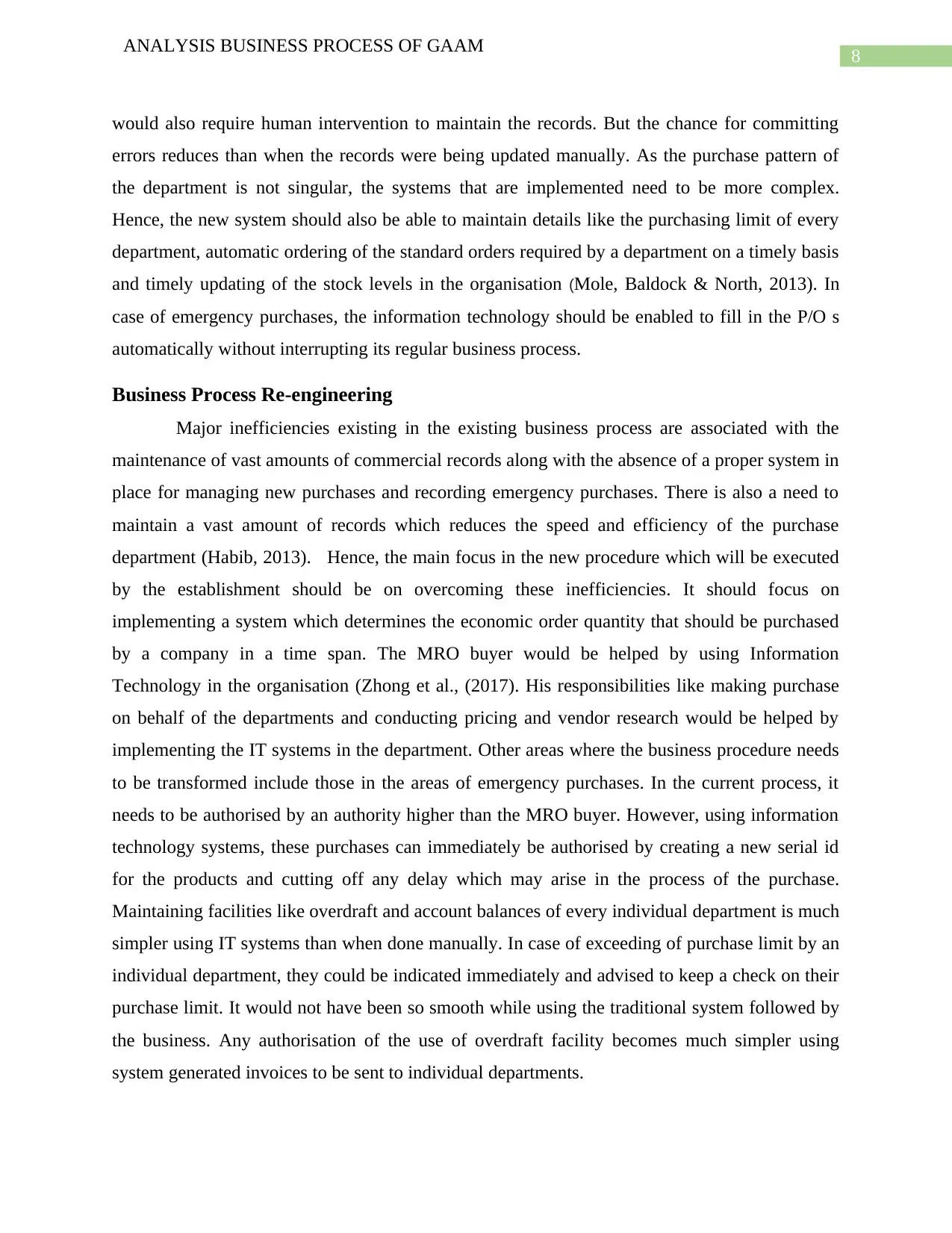
8
ANALYSIS BUSINESS PROCESS OF GAAM
would also require human intervention to maintain the records. But the chance for committing
errors reduces than when the records were being updated manually. As the purchase pattern of
the department is not singular, the systems that are implemented need to be more complex.
Hence, the new system should also be able to maintain details like the purchasing limit of every
department, automatic ordering of the standard orders required by a department on a timely basis
and timely updating of the stock levels in the organisation (Mole, Baldock & North, 2013). In
case of emergency purchases, the information technology should be enabled to fill in the P/O s
automatically without interrupting its regular business process.
Business Process Re-engineering
Major inefficiencies existing in the existing business process are associated with the
maintenance of vast amounts of commercial records along with the absence of a proper system in
place for managing new purchases and recording emergency purchases. There is also a need to
maintain a vast amount of records which reduces the speed and efficiency of the purchase
department (Habib, 2013). Hence, the main focus in the new procedure which will be executed
by the establishment should be on overcoming these inefficiencies. It should focus on
implementing a system which determines the economic order quantity that should be purchased
by a company in a time span. The MRO buyer would be helped by using Information
Technology in the organisation (Zhong et al., (2017). His responsibilities like making purchase
on behalf of the departments and conducting pricing and vendor research would be helped by
implementing the IT systems in the department. Other areas where the business procedure needs
to be transformed include those in the areas of emergency purchases. In the current process, it
needs to be authorised by an authority higher than the MRO buyer. However, using information
technology systems, these purchases can immediately be authorised by creating a new serial id
for the products and cutting off any delay which may arise in the process of the purchase.
Maintaining facilities like overdraft and account balances of every individual department is much
simpler using IT systems than when done manually. In case of exceeding of purchase limit by an
individual department, they could be indicated immediately and advised to keep a check on their
purchase limit. It would not have been so smooth while using the traditional system followed by
the business. Any authorisation of the use of overdraft facility becomes much simpler using
system generated invoices to be sent to individual departments.
ANALYSIS BUSINESS PROCESS OF GAAM
would also require human intervention to maintain the records. But the chance for committing
errors reduces than when the records were being updated manually. As the purchase pattern of
the department is not singular, the systems that are implemented need to be more complex.
Hence, the new system should also be able to maintain details like the purchasing limit of every
department, automatic ordering of the standard orders required by a department on a timely basis
and timely updating of the stock levels in the organisation (Mole, Baldock & North, 2013). In
case of emergency purchases, the information technology should be enabled to fill in the P/O s
automatically without interrupting its regular business process.
Business Process Re-engineering
Major inefficiencies existing in the existing business process are associated with the
maintenance of vast amounts of commercial records along with the absence of a proper system in
place for managing new purchases and recording emergency purchases. There is also a need to
maintain a vast amount of records which reduces the speed and efficiency of the purchase
department (Habib, 2013). Hence, the main focus in the new procedure which will be executed
by the establishment should be on overcoming these inefficiencies. It should focus on
implementing a system which determines the economic order quantity that should be purchased
by a company in a time span. The MRO buyer would be helped by using Information
Technology in the organisation (Zhong et al., (2017). His responsibilities like making purchase
on behalf of the departments and conducting pricing and vendor research would be helped by
implementing the IT systems in the department. Other areas where the business procedure needs
to be transformed include those in the areas of emergency purchases. In the current process, it
needs to be authorised by an authority higher than the MRO buyer. However, using information
technology systems, these purchases can immediately be authorised by creating a new serial id
for the products and cutting off any delay which may arise in the process of the purchase.
Maintaining facilities like overdraft and account balances of every individual department is much
simpler using IT systems than when done manually. In case of exceeding of purchase limit by an
individual department, they could be indicated immediately and advised to keep a check on their
purchase limit. It would not have been so smooth while using the traditional system followed by
the business. Any authorisation of the use of overdraft facility becomes much simpler using
system generated invoices to be sent to individual departments.
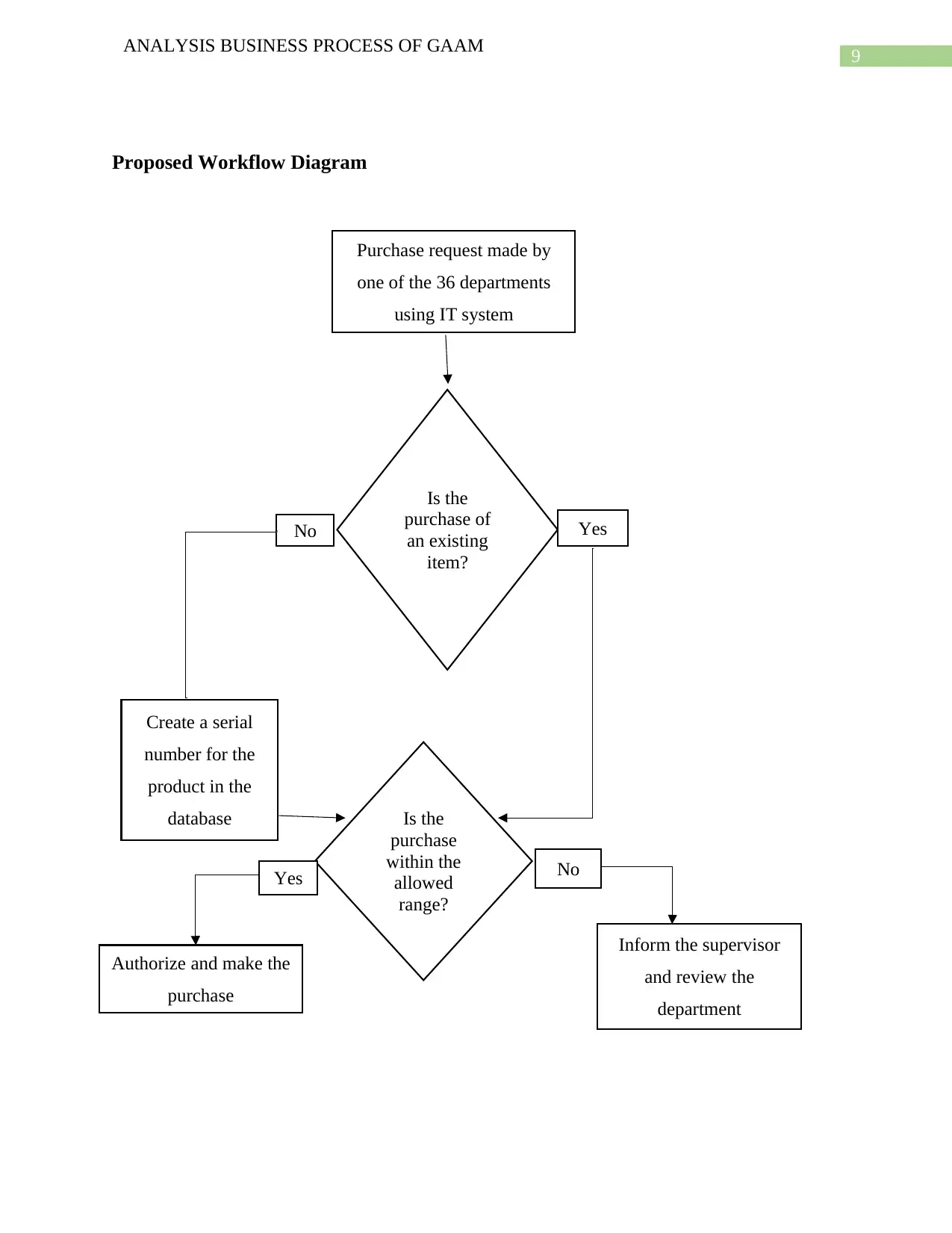
9
ANALYSIS BUSINESS PROCESS OF GAAM
Proposed Workflow Diagram
Purchase request made by
one of the 36 departments
using IT system
Is the
purchase of
an existing
item?
Is the
purchase
within the
allowed
range?
No Yes
Create a serial
number for the
product in the
database
Yes No
Authorize and make the
purchase
Inform the supervisor
and review the
department
ANALYSIS BUSINESS PROCESS OF GAAM
Proposed Workflow Diagram
Purchase request made by
one of the 36 departments
using IT system
Is the
purchase of
an existing
item?
Is the
purchase
within the
allowed
range?
No Yes
Create a serial
number for the
product in the
database
Yes No
Authorize and make the
purchase
Inform the supervisor
and review the
department
Secure Best Marks with AI Grader
Need help grading? Try our AI Grader for instant feedback on your assignments.
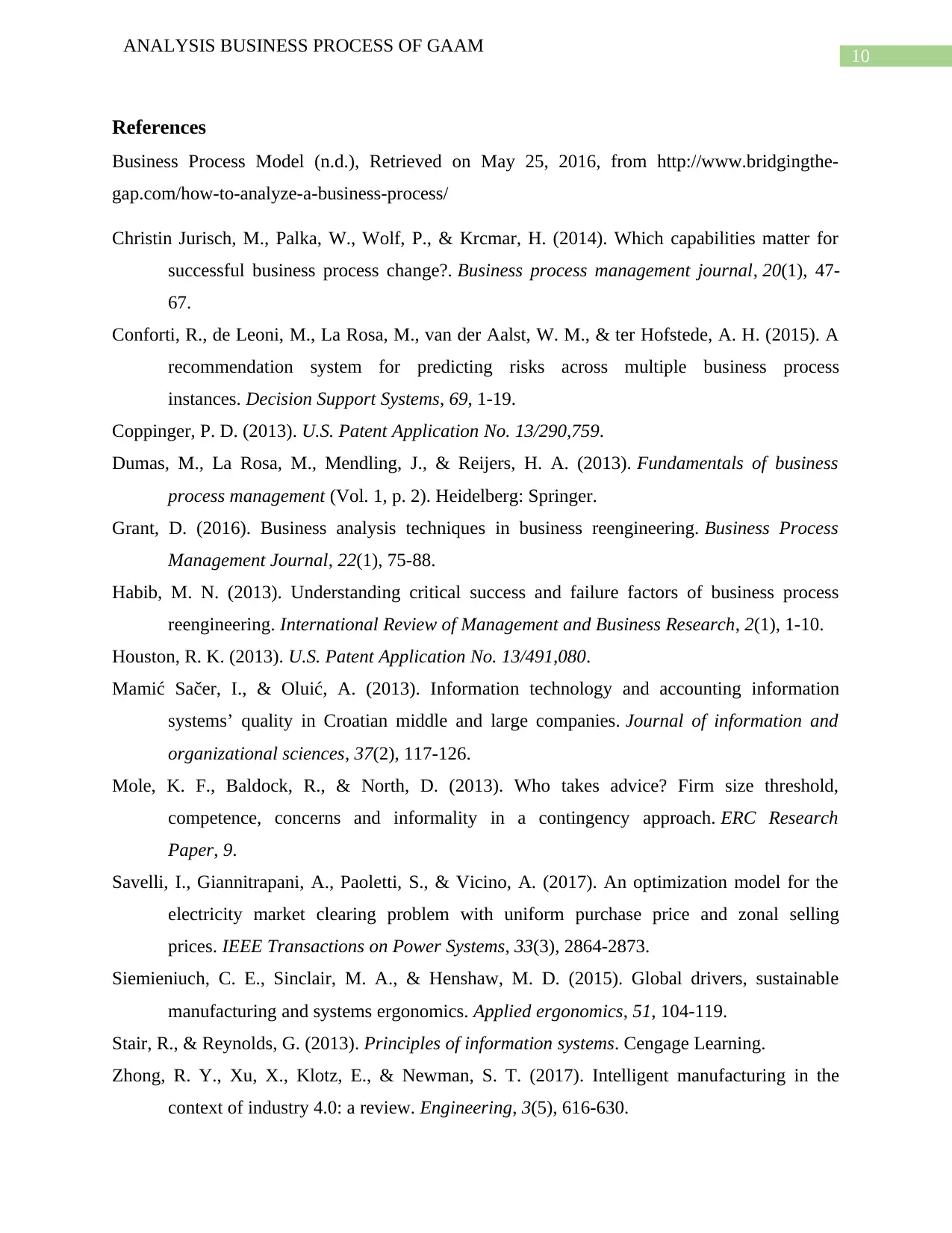
10
ANALYSIS BUSINESS PROCESS OF GAAM
References
Business Process Model (n.d.), Retrieved on May 25, 2016, from http://www.bridgingthe-
gap.com/how-to-analyze-a-business-process/
Christin Jurisch, M., Palka, W., Wolf, P., & Krcmar, H. (2014). Which capabilities matter for
successful business process change?. Business process management journal, 20(1), 47-
67.
Conforti, R., de Leoni, M., La Rosa, M., van der Aalst, W. M., & ter Hofstede, A. H. (2015). A
recommendation system for predicting risks across multiple business process
instances. Decision Support Systems, 69, 1-19.
Coppinger, P. D. (2013). U.S. Patent Application No. 13/290,759.
Dumas, M., La Rosa, M., Mendling, J., & Reijers, H. A. (2013). Fundamentals of business
process management (Vol. 1, p. 2). Heidelberg: Springer.
Grant, D. (2016). Business analysis techniques in business reengineering. Business Process
Management Journal, 22(1), 75-88.
Habib, M. N. (2013). Understanding critical success and failure factors of business process
reengineering. International Review of Management and Business Research, 2(1), 1-10.
Houston, R. K. (2013). U.S. Patent Application No. 13/491,080.
Mamić Sačer, I., & Oluić, A. (2013). Information technology and accounting information
systems’ quality in Croatian middle and large companies. Journal of information and
organizational sciences, 37(2), 117-126.
Mole, K. F., Baldock, R., & North, D. (2013). Who takes advice? Firm size threshold,
competence, concerns and informality in a contingency approach. ERC Research
Paper, 9.
Savelli, I., Giannitrapani, A., Paoletti, S., & Vicino, A. (2017). An optimization model for the
electricity market clearing problem with uniform purchase price and zonal selling
prices. IEEE Transactions on Power Systems, 33(3), 2864-2873.
Siemieniuch, C. E., Sinclair, M. A., & Henshaw, M. D. (2015). Global drivers, sustainable
manufacturing and systems ergonomics. Applied ergonomics, 51, 104-119.
Stair, R., & Reynolds, G. (2013). Principles of information systems. Cengage Learning.
Zhong, R. Y., Xu, X., Klotz, E., & Newman, S. T. (2017). Intelligent manufacturing in the
context of industry 4.0: a review. Engineering, 3(5), 616-630.
ANALYSIS BUSINESS PROCESS OF GAAM
References
Business Process Model (n.d.), Retrieved on May 25, 2016, from http://www.bridgingthe-
gap.com/how-to-analyze-a-business-process/
Christin Jurisch, M., Palka, W., Wolf, P., & Krcmar, H. (2014). Which capabilities matter for
successful business process change?. Business process management journal, 20(1), 47-
67.
Conforti, R., de Leoni, M., La Rosa, M., van der Aalst, W. M., & ter Hofstede, A. H. (2015). A
recommendation system for predicting risks across multiple business process
instances. Decision Support Systems, 69, 1-19.
Coppinger, P. D. (2013). U.S. Patent Application No. 13/290,759.
Dumas, M., La Rosa, M., Mendling, J., & Reijers, H. A. (2013). Fundamentals of business
process management (Vol. 1, p. 2). Heidelberg: Springer.
Grant, D. (2016). Business analysis techniques in business reengineering. Business Process
Management Journal, 22(1), 75-88.
Habib, M. N. (2013). Understanding critical success and failure factors of business process
reengineering. International Review of Management and Business Research, 2(1), 1-10.
Houston, R. K. (2013). U.S. Patent Application No. 13/491,080.
Mamić Sačer, I., & Oluić, A. (2013). Information technology and accounting information
systems’ quality in Croatian middle and large companies. Journal of information and
organizational sciences, 37(2), 117-126.
Mole, K. F., Baldock, R., & North, D. (2013). Who takes advice? Firm size threshold,
competence, concerns and informality in a contingency approach. ERC Research
Paper, 9.
Savelli, I., Giannitrapani, A., Paoletti, S., & Vicino, A. (2017). An optimization model for the
electricity market clearing problem with uniform purchase price and zonal selling
prices. IEEE Transactions on Power Systems, 33(3), 2864-2873.
Siemieniuch, C. E., Sinclair, M. A., & Henshaw, M. D. (2015). Global drivers, sustainable
manufacturing and systems ergonomics. Applied ergonomics, 51, 104-119.
Stair, R., & Reynolds, G. (2013). Principles of information systems. Cengage Learning.
Zhong, R. Y., Xu, X., Klotz, E., & Newman, S. T. (2017). Intelligent manufacturing in the
context of industry 4.0: a review. Engineering, 3(5), 616-630.
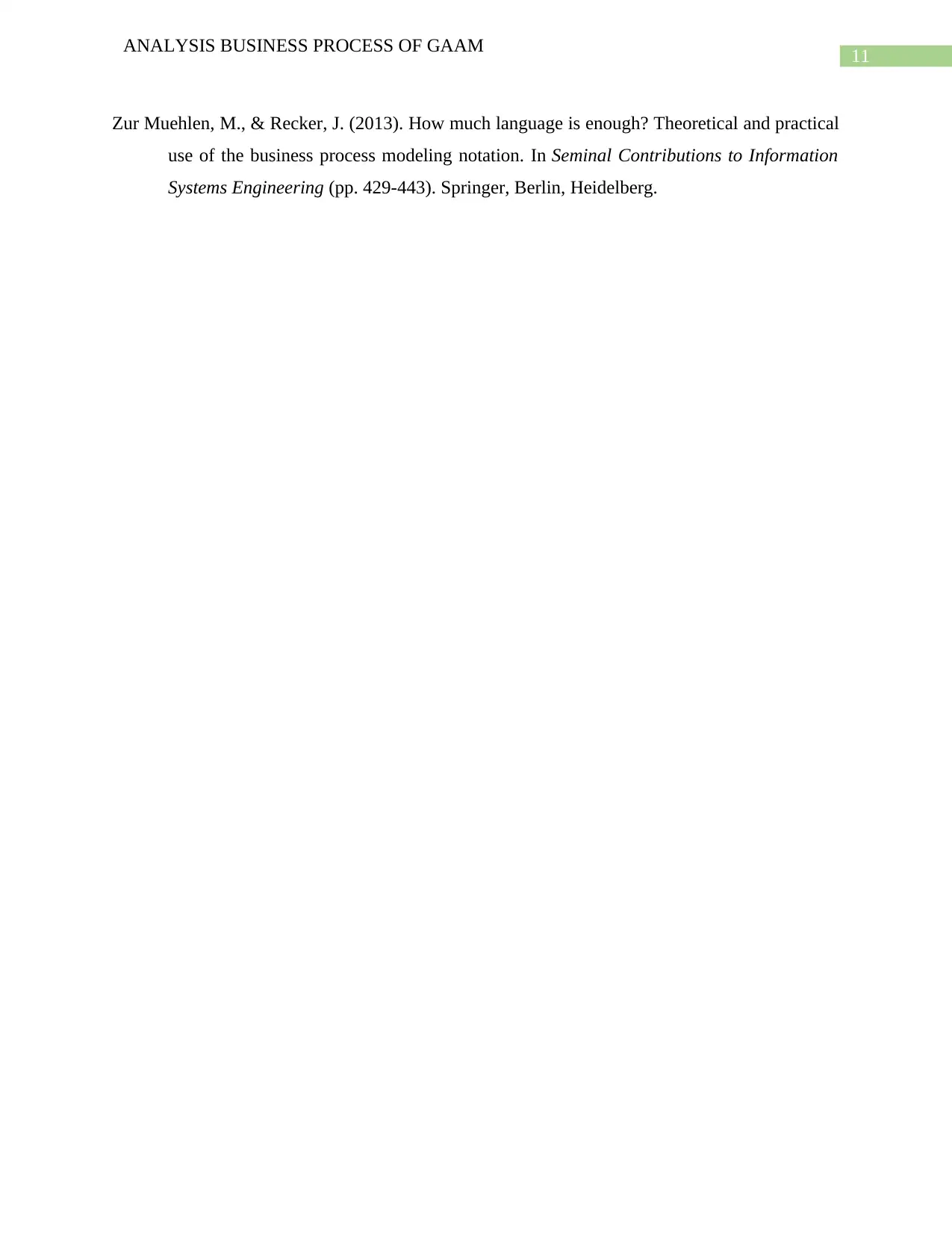
11
ANALYSIS BUSINESS PROCESS OF GAAM
Zur Muehlen, M., & Recker, J. (2013). How much language is enough? Theoretical and practical
use of the business process modeling notation. In Seminal Contributions to Information
Systems Engineering (pp. 429-443). Springer, Berlin, Heidelberg.
ANALYSIS BUSINESS PROCESS OF GAAM
Zur Muehlen, M., & Recker, J. (2013). How much language is enough? Theoretical and practical
use of the business process modeling notation. In Seminal Contributions to Information
Systems Engineering (pp. 429-443). Springer, Berlin, Heidelberg.
1 out of 12
Related Documents
Your All-in-One AI-Powered Toolkit for Academic Success.
+13062052269
info@desklib.com
Available 24*7 on WhatsApp / Email
![[object Object]](/_next/static/media/star-bottom.7253800d.svg)
Unlock your academic potential
© 2024 | Zucol Services PVT LTD | All rights reserved.




